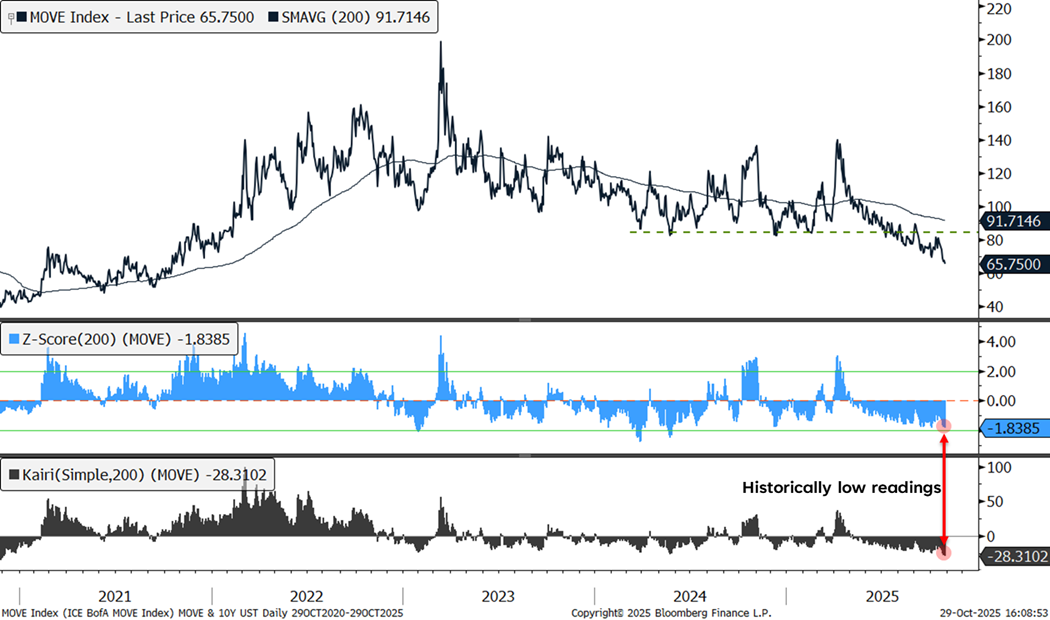Eos Energy stock falls after Fuzzy Panda issues short report
The more things change, the more they stay the same. As widely expected, the Federal Reserve (Fed) cut interest rates by 0.25% at its October Federal Open Market Committee (FOMC) meeting yesterday. Similar to last month, the accompanying policy statement noted that economic activity has been expanding at a moderate pace, and the unemployment rate remained low, despite rising downside risks to the labor market. With limited economic data available due to the ongoing government shutdown (outside of private sector data), there were few surprises in the press release. Recently appointed Fed Governor Stephen Miran dissented again, favoring a 0.50% interest rate cut, while Fed Governor Jeffrey Schmid preferred no change to the target range this month — a new dissenter since the September FOMC meeting (he voted in favor of a 0.25% cut last month).
Underneath the headline of the expected rate cut, policymakers also decided to end quantitative tightening beginning December 1 — a policy that aims to tighten financial conditions by reducing the pace of reinvestments of proceeds from maturing bonds the Fed holds on its balance sheet, thereby reducing the money supply in the market. This came as no surprise to Fedwatchers, including our own Chief Fixed Income Strategist Lawrence Gillum, who covered this exact topic last week.
As a backdrop, the Fed has reduced its balance sheet by over $2 trillion since QT began three years ago, mainly through a drop in its overnight reverse repo program, which is now around $19 billion. Ending QT was always part of the plan, but signs of liquidity pressures building over the last few weeks motivated the Fed to make the announcement on Wednesday.
Outside of the expected rate cut and the end of QT announcement, there were a few surprises in Fed Chair Powell’s post-FOMC press conference:
- A December rate cut is not guaranteed. Chair Powell made this very clear before the Q&A portion of the press conference, noting that “Further reduction in the policy rate at the December meeting is not a foregone conclusion, far from it.” He further added there were “strong differing views about how to proceed in December.”
- According to the Fed, the economy is “solid and stable” since the September FOMC meeting. Growth is expanding moderately, with the Fed expecting real GDP growth of 1.6% this year, down “a couple of tenths” if not for the shutdown.
- Weakness in the labor market is not accelerating. Powell explained that the supply of workers has significantly decreased due to immigration. At the same time, labor-force participation has slowed, suggesting less demand for new jobs as fewer people are seeking employment. He also noted the reduced supply in the labor market is running into a backdrop of less demand for hiring, aligning with the “no hire, no fire” theme characterizing the job market right now.
- Inflation remains elevated, with upside risks. Powell delineated between the disinflation trend in the services sector, especially housing, and a recent uptick in inflation for goods, an increase he attributed to tariffs rather than “broader inflationary pressures.” He further added that after stripping out the tariff impact on pricing pressures, inflation is not that far away from the Fed’s 2% target.
- The market expected a more dovish outcome. Treasury yields rose, stocks fell, and the dollar rose immediately after the press conference began. Furthermore, the fed funds futures market reduced expectations of a rate cut. For December, implied probabilities are now at 69% for a 0.25% reduction, down from 100% yesterday.
Arguably, the biggest takeaway from yesterday’s FOMC meeting was Powell highlighting that another rate cut in December is no guarantee. His statement caught the market a little off guard as it reduced visibility into future rate cuts and highlighted a growing divide among policymakers. For markets, reduced visibility usually means the potential for upside volatility risk, especially in the fixed income market.
The MOVE Index — a standard measure of implied fixed-income market volatility, with higher readings equating to higher expectations for 30-day Treasury market volatility and vice versa — is trading at nearly a four-year low. The MOVE Index’s current 66 reading is almost two standard deviations below its longer-term average and represents a historically low 28% discount to its 200-day moving average (dma). With volatility tending to mean-revert, an uptick in implied Treasury market volatility from here shouldn’t come as a surprise.

Source: LPL Research, Bloomberg 09/03/25
Disclosures: Past performance is no guarantee of future results.
